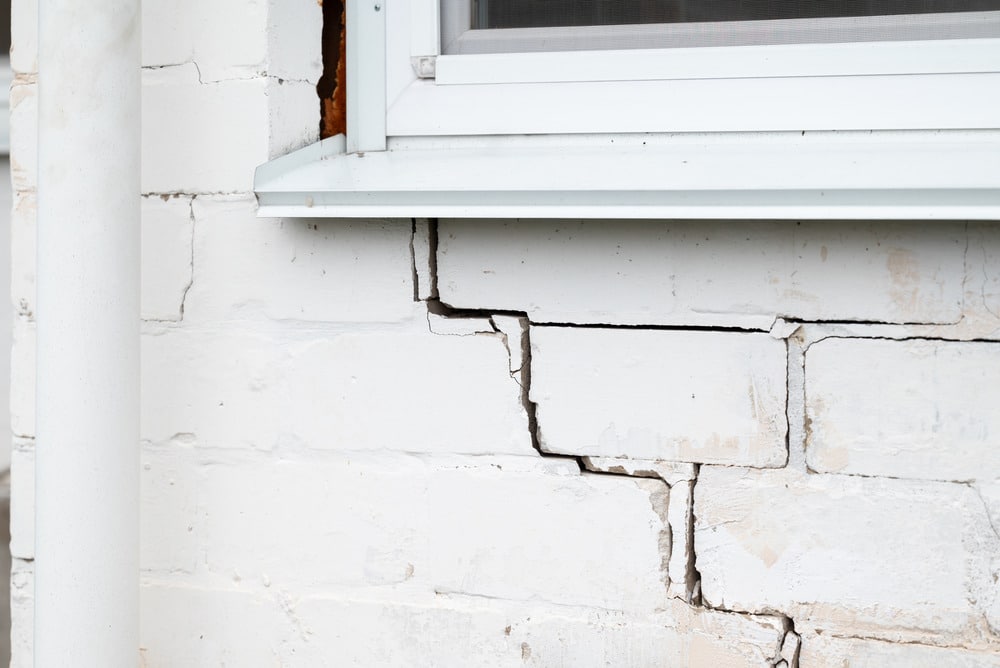Foundation cracks are a common issue in most homes. While some cracks are not serious, some may signal structural damage. Cracks can form in different directions, each indicating specific foundation problems. To properly assess the severity of cracks, it’s important to understand their characteristics. In this blog, we will explore two main types of foundation cracks: vertical and horizontal cracks. We will provide a detailed comparison between vertical and horizontal cracks, including common causes, repair methods, and preventive measures.
What Are Foundation Cracks?
Foundation cracks are fissures that form in your foundation walls and floors. They primarily appear due to external pressure, poor foundation construction, and drainage issues. These cracks manifest in different forms, each indicating a different issue. The distinct types of cracks include vertical, horizontal, hairline, stair-step, and diagonal cracks.
Understanding Vertical Foundation Cracks
Vertical foundation cracks run along a straight line, up and down your foundation walls. They are one of the most frequently seen types of cracks and are typically the result of concrete shrinkage or minor foundation settling. These cracks are usually narrow and do not expand significantly over time. They are less severe but can lead to issues such as water seepage if left unaddressed.
Common Causes of Vertical Foundation Cracks
The following are the common causes of vertical cracks on foundation walls:
Natural Settling or Shrinkage
All new homes go through an initial phase where the foundation naturally adjusts and settles into the ground. Additionally, the natural drying and hardening of the concrete can cause the material to lose moisture and shrink. These conditions induce mild tension on the foundation walls, leading to the formation of vertical hairline cracks.
Minor Soil Shifting
The soil surrounding your foundation is not completely compact. As the foundation settles, the soil can experience subtle movement due to minor soil compression or erosion. This movement can contribute to the formation of vertical cracks in your foundation walls.
Foundation Settlement
Your foundation settles when the soil below the structure experiences downward movement due to the weight of the structure. This is a normal process that occurs gradually over time. As the entire structure gradually shifts downward, your foundation walls may develop minor vertical cracks. However, if the settling is severe or uneven, the cracks may expand or be horizontal, potentially indicating a severe structural problem.
Poor Construction Practices
The quality of your foundation determines the longevity and stability of your structure. Practices such as poor soil compaction, the use of low-grade materials, and insufficient reinforcement make the foundation vulnerable to external pressure and reduce its capacity to bear the structural load of your home. Your foundation may develop vertical cracks early on if poor construction practices were used.
Are Vertical Foundation Cracks Serious?
Vertical cracks in your foundation commonly stem from minor concrete shrinkage or settling over time. These hairline cracks are usually cosmetic and do not pose an immediate structural threat. However, you should not dismiss these cracks entirely. They may evolve into more serious concerns if they are left unaddressed. Regularly monitoring whether the cracks are widening or leaking is essential to understanding the severity of the issue.
Understanding Horizontal Foundation Cracks
Horizontal cracks in your foundation run parallel to the ground. They are commonly caused by immense pressure from the surrounding soil. As these cracks are often an indication of weakening structural integrity, fixing them requires solutions that properly address the underlying cause.
Common Causes of Horizontal Foundation Cracks
Here are the common causes of horizontal cracks in your foundation:
Hydrostatic Pressure
Hydrostatic pressure exerts intense lateral pressure against the foundation walls. Due to this constant pressure, the walls bend inward and develop horizontal cracks at the point where the stress is concentrated.
Soil Expansion
Soil containing a high amount of clay is expansive in nature. It quickly absorbs water and expands, pushing against the foundation walls. This external force can easily lead to horizontal cracks, posing a risk to structural integrity and water intrusion.
Frost Heave
Freezing temperatures during colder weather cause the soil underneath your foundation to freeze and expand, pushing upwards. The soil contracts when the ice melts. This repeated movement of the soil exerts uneven pressure on the foundation, which manifests as horizontal cracks.
Poor Drainage
If your water management system is not effective, water may pool around your home’s foundation. This leads to saturated soil around your home, resulting in soil expansion and hydrostatic pressure. This process can contribute to the formation of horizontal cracks in your foundation walls.
Poor Construction
Low-quality construction materials and improper construction techniques lower your foundation’s resilience against excessive stress. Due to a lack of strength, the foundation may become susceptible to horizontal cracks.
Foundation Settlement
Excessive uneven settlement of the foundation causes parts of it to sink into the ground. This movement creates uneven stress on the structure, which contributes to horizontal cracking. This type of crack gradually increases in width and length.
Heavy Objects Placed Near the Foundation
Storing heavy objects against the foundation wall adds additional stress or pressure to the foundation walls. When the pressure from heavy objects builds up, it can lead to weakening of the walls and horizontal cracking.
Are Horizontal Foundation Cracks Serious?
Horizontal cracks in your foundation are often an indication of serious issues with structural integrity. Unlike other types of cracks, horizontal cracks signal that the foundation wall is no longer able to withstand the external pressure or the structural load. This often causes bowing or cracking. If the problem persists, it may ultimately lead to the collapse of the foundation wall. An immediate professional inspection is needed to prevent the foundation from failing and restore its structural integrity.
Vertical vs. Horizontal Cracks: Key Differences
Here are the main distinctions between vertical and horizontal cracks:
Cause
Vertical cracks are usually caused by concrete shrinkage during curing or natural settling. Horizontal cracks are generally caused by excessive external stress, such as hydrostatic pressure from soil saturated with water.
Severity
Vertical cracks are considered a minor, cosmetic issue that rarely affects the structural integrity of your home. Horizontal cracks are more serious, usually indicating ongoing structural weakening.
Risk
The major risk of a vertical crack is water seepage, which can lead to moisture problems and mold. A horizontal crack poses the risk of structural weakening, potentially leading to collapse.
Action Required
Vertical cracks require cosmetic fixes like applying epoxy or polyurethane. Horizontal cracks demand a more extensive solution that focuses on structural reinforcement and stabilization.
What to Do if You Spot Cracks in Your Foundation
Here are the steps you can follow to mitigate the cracks in your foundation:
Inspect the Crack
Assess the crack and pay attention to its direction and width. Check for signs of moisture, and monitor its width and length. These details help determine the severity of the crack.
Protect Your Foundation
Act promptly if you notice the following signs of foundation damage:
- Cracks that are horizontal or stair-step: These patterns may indicate serious structural stress caused by intense lateral pressure or uneven settling.
- Cracks that are growing: If the crack is growing, this is an indication of active movement or shifting of the foundation.
- Water intrusion: Water seeping through cracks can cause issues such as mold and pest infestation, which need to be addressed immediately.
- There are structural symptoms: Signs of structural damage, such as sloping floors or sticking doors, can gradually grow into a severe issue.
Contact a Professional
Reach out to a licensed foundation expert for a detailed assessment. They will identify the main cause of the cracks and implement a suitable repair solution to address the issue at its core.
Professional Repair Options for Vertical and Horizontal Cracks
These are some of the common repair options used for addressing vertical and horizontal cracks:
For Vertical Cracks
- Crack injection or sealing: Epoxy or polyurethane injections are minimally invasive methods to seal vertical cracks. This is a cost-efficient and lasting solution. PVC patches can also be placed over cracks to redirect water to a drainage system.
For Horizontal Cracks
- Carbon fiber straps: This is a durable repair solution that involves applying carbon fiber straps to cracked walls using epoxy sealants.
- Wall anchors or braces: These methods help stabilize foundation walls and restore their strength. It involves using steel anchors or braces to offer support and stability to bowing or cracked walls.
Preventing Future Foundation Cracks
Here are some practical tips for foundation crack prevention:
Maintain Proper Drainage Around Your Home
Maintaining a proper drainage system for your foundation is the best way to mitigate the risk of foundation cracks. This may involve installing a sump pump, French drain, gutter, and downspout extensions.
Grade the Soil Away From the Foundation
The ground surrounding your foundation should slope away from your foundation. This allows surface water to drain away from the property naturally, preventing water from accumulating around the foundation. Proper grading minimizes the risk of water seepage and soil expansion near the foundation.
Install and Maintain Gutters and Downspouts
Gutters and downspouts protect your foundation from rainwater infiltration and soil expansion. These systems channel roof runoff away from your property.
Avoid Overwatering Near the Foundation
Do not overwater the soil near your foundation. This can lead to soil saturation and expansion, resulting in increased hydrostatic pressure against your foundation walls.
Schedule Regular Foundation Inspections
Routine professional foundation inspections can help identify issues early before they escalate into major problems. Make sure to hire a qualified specialist who can recommend effective solutions.
Final Thoughts
Vertical and horizontal cracks both demand detailed professional inspection and effective repair solutions. If you are noticing any cracks in your foundation, don’t wait for the issue to get worse. Contact Bluebird CFW right away and schedule a professional inspection. Our experienced foundation repair specialists in Michigan will provide a comprehensive inspection and expert repair solutions tailored to your property’s needs.





